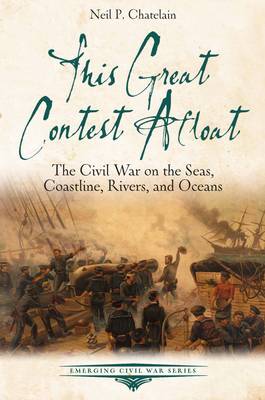
- Afhalen na 1 uur in een winkel met voorraad
- Gratis thuislevering in België vanaf € 30
- Ruim aanbod met 7 miljoen producten
- Afhalen na 1 uur in een winkel met voorraad
- Gratis thuislevering in België vanaf € 30
- Ruim aanbod met 7 miljoen producten
Zoeken
€ 23,95
+ 47 punten
Omschrijving
"History offers no example where so much was accomplished in so short a time, or where so many events were crowded into the space of four years, in which the Navy was employed subduing a coast over four thousand miles in length, and recapturing a river-coast of more than five thousand miles," wrote Rear Admiral David Dixon Porter in his 1886 The Naval History of the Civil War.
Porter's words demonstrate the true scale of the Civil War's naval activity. Thousands of ships took part in the conflict, fighting battles alongside the great armies, and patrolling around the globe. The actions of more than 100,000 sailors on both sides impacted the war's military, naval, economic, and diplomatic aspects, all while providing the tools to realize the Anaconda Plan of isolating and splitting the Confederacy.
Unlike the army dividing its efforts into the Eastern, Western, and Trans-Mississippi theaters, the Civil War's naval forces fought in four distinct theaters of conflict. The offshore blockade was an economic and logistical campaign waged over whether Confederate armies would remain properly supplied. Sailors enacting that blockade simultaneously worked in tandem with armies to assault cities and coastal areas to deny the Confederacy its ports and coastal infrastructure, all while Confederate sailors fought to both break the blockade and keep control of its ports. Meanwhile, fleets on both sides battled for control over the Mississippi River valley, with a split Confederacy at stake. Finally, an economic and diplomatic war was waged across the oceans, where Confederate privateers and commerce raiders prowled for Federal merchants.
In This Great Contest Afloat: The Civil War on the Seas, Coastline, Rivers, and Oceans, award-winning historian and professor Neil P. Chatelain unpacks each of these naval theaters. Using prolific firsthand accounts merged with keen macro analysis, Chatelain takes readers to the decks of blockade-runners, beaches of coastal assaults, riverine ironclads, and targeted merchants, showing the extent and impact of Civil War naval activity.
Porter's words demonstrate the true scale of the Civil War's naval activity. Thousands of ships took part in the conflict, fighting battles alongside the great armies, and patrolling around the globe. The actions of more than 100,000 sailors on both sides impacted the war's military, naval, economic, and diplomatic aspects, all while providing the tools to realize the Anaconda Plan of isolating and splitting the Confederacy.
Unlike the army dividing its efforts into the Eastern, Western, and Trans-Mississippi theaters, the Civil War's naval forces fought in four distinct theaters of conflict. The offshore blockade was an economic and logistical campaign waged over whether Confederate armies would remain properly supplied. Sailors enacting that blockade simultaneously worked in tandem with armies to assault cities and coastal areas to deny the Confederacy its ports and coastal infrastructure, all while Confederate sailors fought to both break the blockade and keep control of its ports. Meanwhile, fleets on both sides battled for control over the Mississippi River valley, with a split Confederacy at stake. Finally, an economic and diplomatic war was waged across the oceans, where Confederate privateers and commerce raiders prowled for Federal merchants.
In This Great Contest Afloat: The Civil War on the Seas, Coastline, Rivers, and Oceans, award-winning historian and professor Neil P. Chatelain unpacks each of these naval theaters. Using prolific firsthand accounts merged with keen macro analysis, Chatelain takes readers to the decks of blockade-runners, beaches of coastal assaults, riverine ironclads, and targeted merchants, showing the extent and impact of Civil War naval activity.
Specificaties
Betrokkenen
- Auteur(s):
- Uitgeverij:
Inhoud
- Aantal bladzijden:
- 192
- Taal:
- Engels
- Reeks:
Eigenschappen
- Productcode (EAN):
- 9781611217773
- Verschijningsdatum:
- 15/05/2026
- Uitvoering:
- Paperback
- Formaat:
- Trade paperback (VS)
- Afmetingen:
- 152 mm x 229 mm

Alleen bij Standaard Boekhandel
+ 47 punten op je klantenkaart van Standaard Boekhandel
Beoordelingen
We publiceren alleen reviews die voldoen aan de voorwaarden voor reviews. Bekijk onze voorwaarden voor reviews.








